
EXPERIMENTAL PLANTATIONS OF FRUIT-BERRY CULTURES AND SELECTION WORK
In the Dendrological Garden, testing of different varieties of black currant was conducted. 60 varieties were tested. With this purpose, the plot of fruit-berry cultures was laid. According to the observation results, the most promising for cultivation in the northern condition varieties of black currant were defined.
On the base of the Garden`s collection, the work on establishment of local varieties of shrubs with high content of vitamins: sea buckthorn and dog rose, was initiated. Selection fund of these cultures was established. Promising forms and main candidates for varieties were selected.
Sea Buckthorn (Hippophae rhamnoides L.). It is valuable multi-vitamin plant. Sea buckthorn exceeds many fruit, berry and other cultures in quantitative and qualitative content of biologically active substances and their effect on human organism.
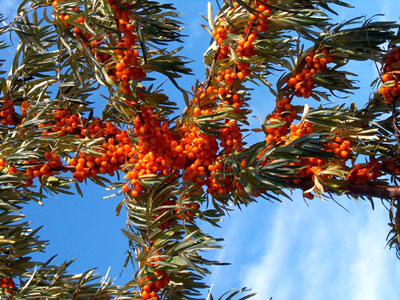
Sea buckthorn is quite suitable for cultivation in the North. Here it fruits regularly and produces fruits of normal size and quality. However varieties selected in other regions of our country are not enough resistant to the conditions of the Arkhangelsk region. In winter they are often frosted over, and when the combination of weather conditions is unfavourable (wet autumn, high snow cover, winter thaws) they perish from root system damping out. Thus necessity of local sustained varieties selection has aroused. Rich selection fund which includes about 300 samples (nearly 65000 of plants) was established using nursery material from different parts of natural sea buckthorn habitat, hybridization, polyploidy and chemical mutagenesis.
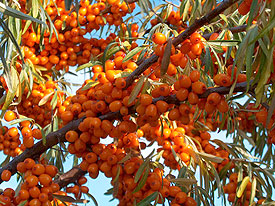
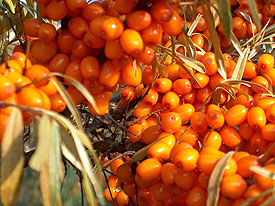
As a result of conducted studies there were selected 121 plants with high winter hardiness. Among these 8 elite forms were picked out for abundant fruiting stability and quality of fruits which could be recommended as candidates for local varieties. Weight of 100 berries reaches 60-100 g, and weight of 10 large fruits reaches 8-13 g. On the European North, sea buckthorn fruits are notable for higher content of vitamin C which varies with years and depends on weather conditions. At the same time the fruits contain less oil and carotene in comparison with existing varieties.
Rosehips (Rosa majalis Herrm.). Among high valuable unpretentious to climate fruit-berry species of our region rosehips attracts a special interest. It is known from time immemorial and interesting first of all as officinal plant.
Since 14-16th centuries potions and decoctions made from rosehips petals, fruits and roots had versatile appliance as wound-healing, antipyretic and antiscorbutic remedy. Only in the 20th century in was found that the main reason of such popularity is extremely rich content of vitamins and other biologically active substances in all parts of the plant: from pollen and petals to bark and roots. The most valuable vitamin-bearing rosehips species are considered those growing in the regions with temperate and cold climate.
In the selection studies, northern species of rosehips from natural habitats, introduced species of rose genus from the Garden`s collection and plants from the progeny of natural populations introduced into the culture by seed sawing were used. The aim of the studies was selection improvement of the northern rosehips and selection of promising forms for establishment of local varieties with high vitamin content for the European North of Russia.
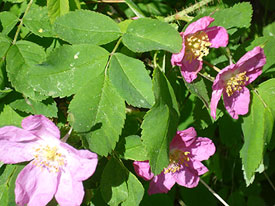
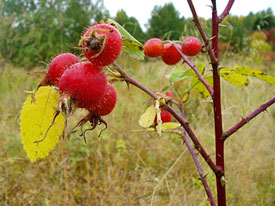
According to the results of the studies of Rosa majalis fruit quality, 40 promising forms were selected by weight of 100 fruits, by content of flesh in the fruits, content of vitamin C and content of oil in seeds.
Also in the Dendrological Garden, there were carried out works on selection improvement and involvement of forest berry plants (lingonberry, blueberry, cloudberry, arctic bramble etc.) into the culture.

